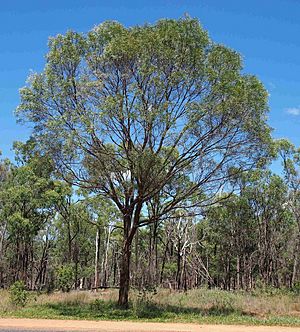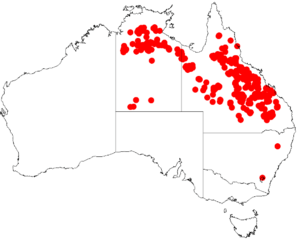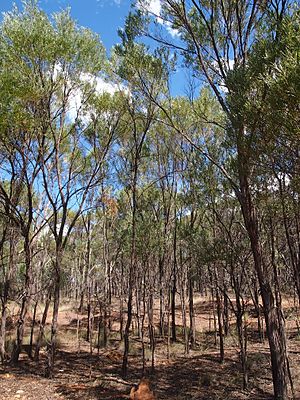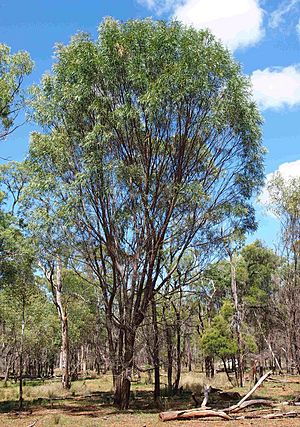Acacia shirleyi facts for kids
Quick facts for kids Acacia shirleyi |
|
|---|---|
 |
|
| Conservation status | |
| Scientific classification | |
| Genus: |
Acacia
|
| Species: |
shirleyi
|
 |
|
| Occurrence data from AVH | |
| Synonyms | |
|
Racosperma shirleyi (Maiden) Pedley |
|
Acacia shirleyi, commonly known as lancewood, is a type of Acacia tree. It grows naturally in Queensland and the Northern Territory in Australia. This tree can reach up to 15 meters (about 49 feet) tall. It has dark grey or black bark that looks like strings, and its leaves are a cool blue-grey color.
Lancewood trees show off their yellow flowers from March to July. You can find them growing in dry, bushy areas, open forests, or mixed savannah woodlands. Long ago, Indigenous Australians used the wood from these trees for fuel and to make hunting spears. Even today, cattle can eat the leaves as food.
Contents
What Does Lancewood Look Like?
This small tree usually has one main trunk. Its bark is made of many layers of dead bark, and its branches spread out like an umbrella. It typically grows to about 15 meters (49 feet) tall.
The bark is dark grey to black and feels stringy. The trunk can grow quite thick, up to 60 centimeters (24 inches) across. If you cut the bark, it might smell a bit like violets!
Leaves and Flowers
The leaves of the lancewood tree stay green all year round. They are long and narrow, usually about 10 to 15 centimeters (4 to 6 inches) long. They are also quite thin, about 0.2 to 0.7 centimeters (0.08 to 0.28 inches) wide. The leaves have a blue-grey color overall.
The tree flowers between March and July. It produces small, bright lemon-yellow flowers on spikes that are about 2 to 3.5 centimeters (0.8 to 1.4 inches) long. After the flowers, the tree grows long, woody, brown seed pods. These pods are about 12 centimeters (4.7 inches) long and 0.45 centimeters (0.18 inches) wide. Inside the pods are black seeds, which are about 4 to 5.5 millimeters (0.16 to 0.22 inches) long.
How Was Lancewood Named?
The lancewood tree was first officially described by a botanist named Joseph Maiden in 1920. He wrote about it in a scientific paper. Later, in 1987, another scientist, Leslie Pedley, changed its name to Racosperma shirleyi. But then, in 2001, it was changed back to its original name, Acacia shirleyi.
Acacia shirleyi is closely related to other Acacia species like Acacia distans and Acacia catenulata. It also looks a bit like Acacia aneura. Sometimes, it can even mix with Acacia rhodoxylon in Queensland to form new types of trees called hybrids.
The name shirleyi was chosen to honor John Shirley. He was an important teacher and scientist who worked with the Royal Society of Queensland for many years.
Where Does Lancewood Grow?
You can find the lancewood tree in warm and dry parts of northeastern Australia. It grows in Queensland and the Northern Territory. The area where it grows is huge, covering about 1,400,000 square kilometers (540,000 square miles).
In Queensland, it grows north and east from places like Toowoomba. It stretches east into the Northern Territory, reaching areas around the Victoria River. Lancewood often grows in monsoon forests or dry scrublands. It is not usually found in rainforests. You can also see it in open forests or mixed savannah woodlands, where it can sometimes form thick groups of trees.
Uses and Growing Lancewood
The wood of the lancewood tree is very hard and heavy. It has a rich dark brown color with lighter wood around the edges. As mentioned, Indigenous Australians used this wood for fuel and to make hunting spears. The bark of the tree contains special substances called tannins. These tannins can be used in medicine to help with problems like diarrhea. However, the wood is not good for fence posts because it tends to rot when it's in the ground.
Lancewood is a tough tree that could be useful for creating windbreaks or privacy screens. Its leaves can also be eaten by cattle.
Growing Conditions
This plant grows well in sunny spots with soil that drains water easily. It can handle dry conditions very well. Lancewood prefers areas where there isn't much frost, but it can survive a light frost. It also grows well in shallow, slightly acidic soils that don't have many nutrients.
When they are young, lancewood seedlings grow slowly. But once they are established, they can grow about 180 centimeters (71 inches) per year! They can even start producing flowers when they are only about 14 months old. Before planting, the seeds need a special treatment called scarification to help them sprout.
Lancewood trees also have a special relationship with certain soil bacteria. This is called a symbiotic relationship. The bacteria form small bumps on the tree's roots and help to add nitrogen from the air into the soil, which is good for the tree and other plants around it.




